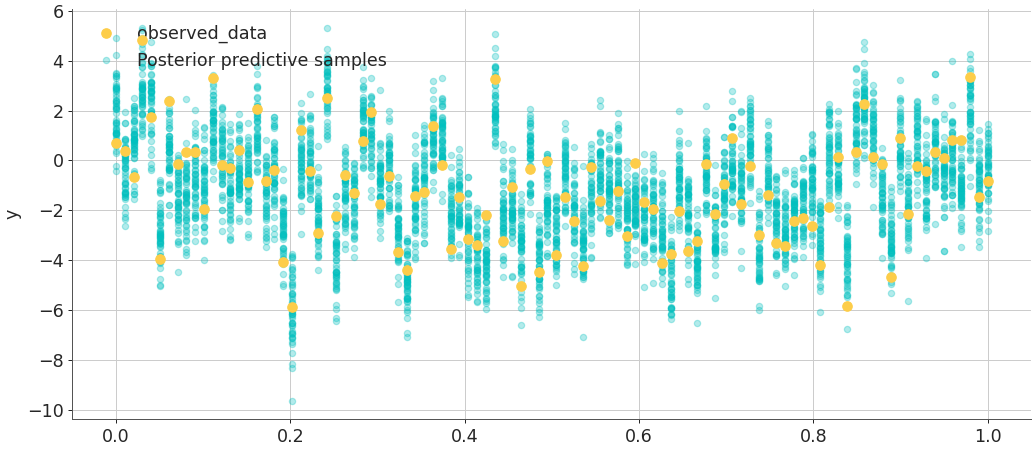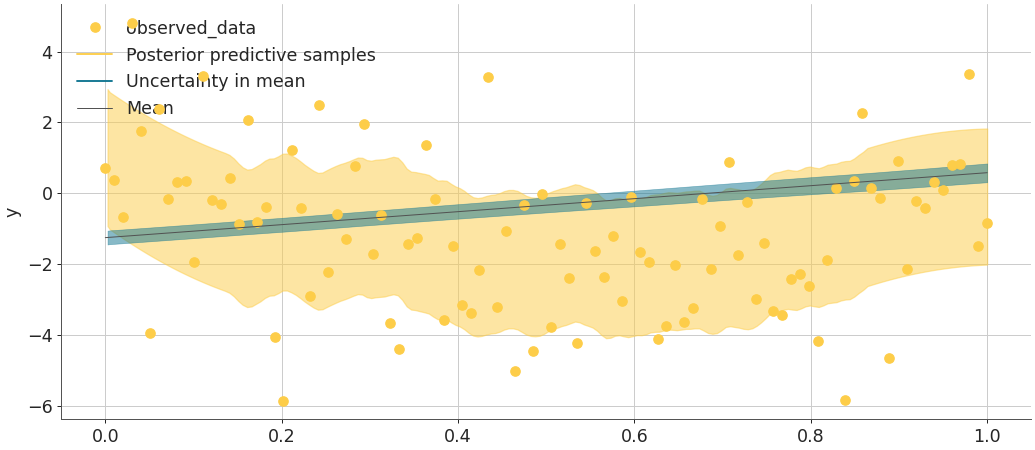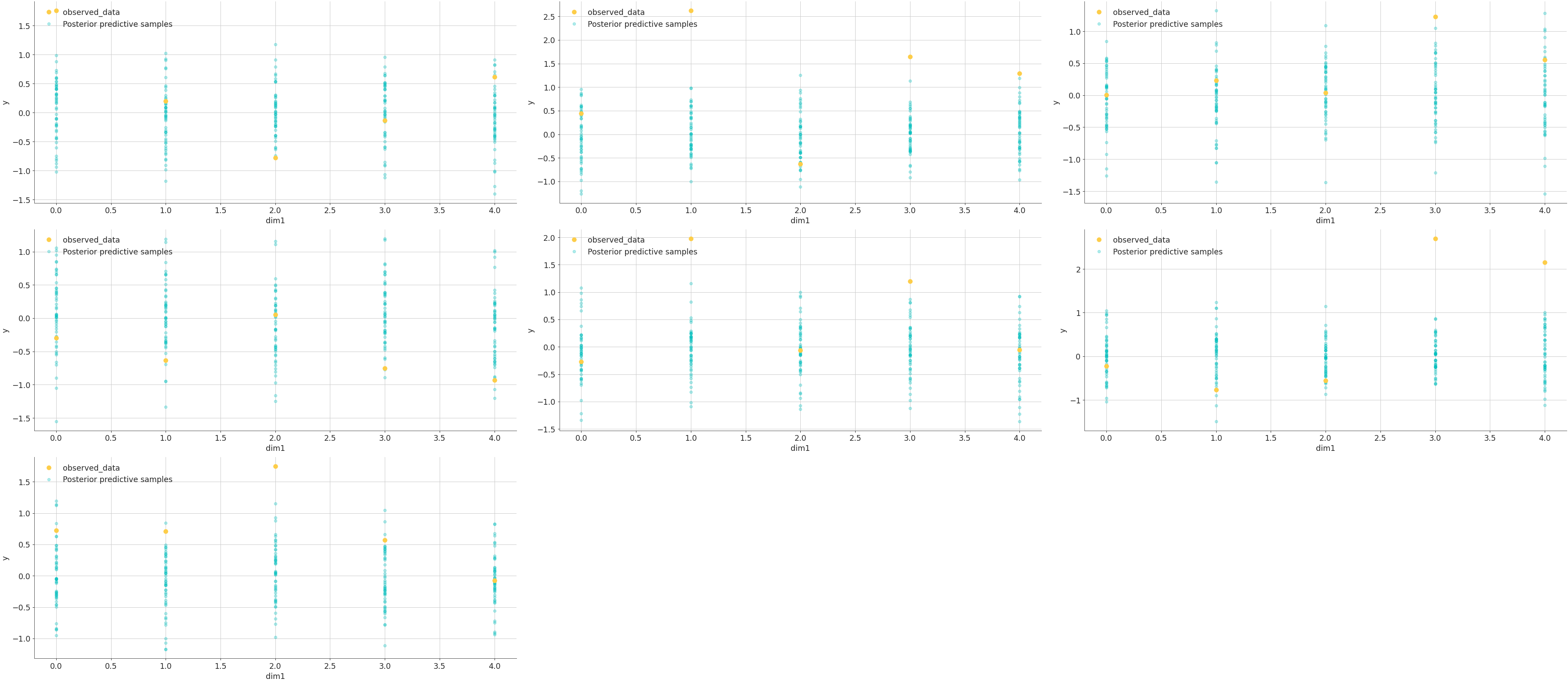arviz.plot_lm#
- arviz.plot_lm(y, idata=None, x=None, y_model=None, y_hat=None, num_samples=50, kind_pp='samples', kind_model='lines', xjitter=False, plot_dim=None, backend=None, y_kwargs=None, y_hat_plot_kwargs=None, y_hat_fill_kwargs=None, y_model_plot_kwargs=None, y_model_fill_kwargs=None, y_model_mean_kwargs=None, backend_kwargs=None, show=None, figsize=None, textsize=None, axes=None, legend=True, grid=True)[source]#
Posterior predictive and mean plots for regression-like data.
- Parameters:
- y
strorDataArrayorndarray If str, variable name from
observed_data.- idata
InferenceData,Optional Optional only if
yis not str.- x
str,tupleofstrings,DataArrayor array_like, optional If str or tuple, variable name from
constant_data. If ndarray, could be 1D, or 2D for multiple plots. If None, coords name ofy(yshould be DataArray).- y_model
strorSequence,Optional If str, variable name from
posterior. Its dimensions should be same asyplus added chains and draws.- y_hat
str,Optional If str, variable name from
posterior_predictive. Its dimensions should be same asyplus added chains and draws.- num_samples
int,Optional,Default50 Significant if
kind_ppis “samples” orkind_modelis “lines”. Number of samples to be drawn from posterior predictive or- kind_pp{“samples”, “hdi”},
Default“samples” Options to visualize uncertainty in data.
- kind_model{“lines”, “hdi”},
Default“lines” Options to visualize uncertainty in mean of the data.
- plot_dim
str,Optional Necessary if
yis multidimensional.- backend
str,Optional Select plotting backend {“matplotlib”,”bokeh”}. Default “matplotlib”.
- y_kwargs
dict, optional Passed to
matplotlib.axes.Axes.plot()in matplotlib andbokeh:bokeh.plotting.Figure.circle()in bokeh- y_hat_plot_kwargs
dict, optional Passed to
matplotlib.axes.Axes.plot()in matplotlib andbokeh:bokeh.plotting.Figure.circle()in bokeh- y_hat_fill_kwargs
dict, optional Passed to
arviz.plot_hdi()- y_model_plot_kwargs
dict, optional Passed to
matplotlib.axes.Axes.plot()in matplotlib andbokeh:bokeh.plotting.Figure.line()in bokeh- y_model_fill_kwargs
dict, optional Significant if
kind_modelis “hdi”. Passed toarviz.plot_hdi()- y_model_mean_kwargs
dict, optional Passed to
matplotlib.axes.Axes.plot()in matplotlib andbokeh:bokeh.plotting.Figure.line()in bokeh- backend_kwargs
dict, optional These are kwargs specific to the backend being used. Passed to
matplotlib.pyplot.subplots()orbokeh.plotting.figure().- figsize(
float,float), optional Figure size. If None it will be defined automatically.
- textsize
float, optional Text size scaling factor for labels, titles and lines. If None it will be autoscaled based on
figsize.- axes2D
numpyarray_like ofmatplotlib Axesorbokeh_figures, optional A 2D array of locations into which to plot the densities. If not supplied, Arviz will create its own array of plot areas (and return it).
- showbool, optional
Call backend show function.
- legendbool, optional
Add legend to figure. By default True.
- gridbool, optional
Add grid to figure. By default True.
- y
- Returns:
- axes:
matplotlibaxesorbokehfigures
- axes:
Examples
Plot regression default plot
>>> import arviz as az >>> import numpy as np >>> import xarray as xr >>> idata = az.load_arviz_data('regression1d') >>> x = xr.DataArray(np.linspace(0, 1, 100)) >>> idata.posterior["y_model"] = idata.posterior["intercept"] + idata.posterior["slope"]*x >>> az.plot_lm(idata=idata, y="y", x=x)

Plot regression data and mean uncertainty
>>> az.plot_lm(idata=idata, y="y", x=x, y_model="y_model")

Plot regression data and mean uncertainty in hdi form
>>> az.plot_lm( ... idata=idata, y="y", x=x, y_model="y_model", kind_pp="hdi", kind_model="hdi" ... )

Plot regression data for multi-dimensional y using plot_dim
>>> data = az.from_dict( ... observed_data = { "y": np.random.normal(size=(5, 7)) }, ... posterior_predictive = {"y": np.random.randn(4, 1000, 5, 7) / 2}, ... dims={"y": ["dim1", "dim2"]}, ... coords={"dim1": range(5), "dim2": range(7)} ... ) >>> az.plot_lm(idata=data, y="y", plot_dim="dim1")

